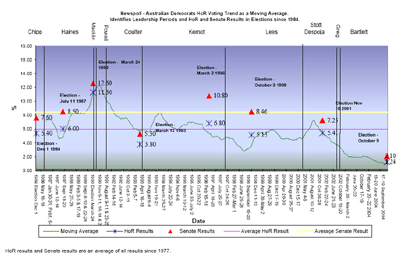Australian Democrats Senator John Cherry posted an article on On Line Opinion: "Where did all the Democrat voters go?" on the February 3, 2005. His views reflect part of his contribution to internal and external discussions on the future of the Party.
Without in any way attempting a critique of his piece, I think its deficiency is that it lacks sufficient historical context. I feel it is important to provide some historical perspectives to assist those opinion interchanges that the Cherry article provokes.
I have provided a two-decade historical graph covering Democrat leaders and polls. I have been providing this (periodically updated) for the Democrats for many years.
Advertisement
The graph stands alone, but for those who lack corporate memory, or who want an interpretation of this material here is a commentary on the graph, adapted from commentary made widely available to the Democrats (from last November) for use in their Future Directions Review.

Click graph to enlarge
Commentary on the Leaders Polls graph
The Democrats were formed from the Australia Party and the Liberal Movement, the former being more “left” of the latter. There is a view that these broad attachments continue as distinct philosophical divisions in the Party.
The Democrats have had 11 leaders in 27 years: a very short average leadership tenure. It is an accepted view that voters react favourably to stable longer-term leadership, and react unfavourably to the reverse. My thesis is that it is therefore no wonder the Democrats have struggled to fulfil their promise.
The Democrats constitution includes the right of members to choose their party leader. This is a core philosophical position, and distinguishes the Democrats from other political parties, but that well-intentioned provision has helped produce leadership churning and periodic instability, fatal for any political party’s relationship with voters.
For 13 years, from 1977 to 1990, the Australian Democrats had just two leaders: Don Chipp and Janine Haines, originally from the Liberal Party and the Liberal Movement respectively.
Advertisement
It is no coincidence that the greater Leader churning in the Democrats after 1990 followed a constitutional change that allowed Democrat members to effectively “recall” a leader.
In the next more than 14 years, from 1990 to 2005, the Democrats have had 9 leaders, (including a couple of interim leaders and the latest leader, Senator Lyn Allison). In the nine years the Coalition has been in power since 1996, the Liberals and the Greens have had one leader, the Nationals two, Labor three, and the Democrats six.
Voters need time to get to know Leaders. Voter support is affected by leader churning and a consequent perception of instability.
Discuss in our Forums
See what other readers are saying about this article!
Click here to read & post comments.
4 posts so far.